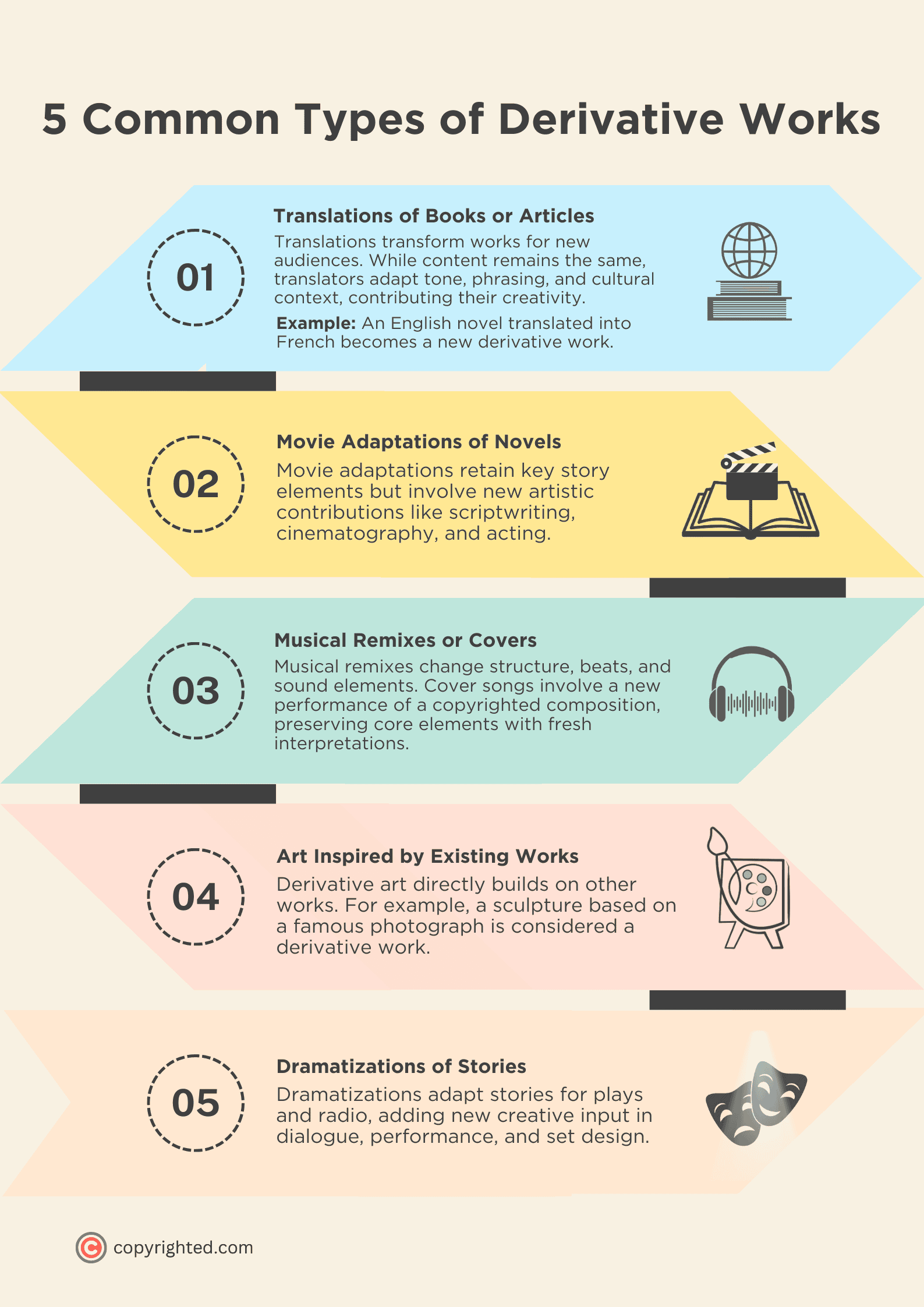Imagine you’ve created something new, like a remix of your favorite song, a fanfiction story, or an edited version of a popular movie. You’ve added your own creativity and effort, but now you’re wondering, “Is it legal for me to use this content?”
This question ties into the concept of derivative works under copyright law. Copyright protects not only original works but also adaptations and modifications of work based upon one or more preexisting works.
For content creators, business owners, and anyone dealing with intellectual property, knowing these rules is important to avoid legal trouble like a copyright infringement lawsuit.
This article explains what qualifies as a derivative work, how copyright laws apply, and what rights you do or do not have when modifying someone else’s creation.
- A derivative work involves modifying or adapting an existing work by adding new, creative elements that are eligible for separate copyright protection.
- Copyright law requires derivative works to include substantial, original contributions to qualify for protection while still respecting the rights of the owner of the original work.
- Creators of derivative works can own the rights to their original contributions but must often obtain permission to use or distribute the underlying material to avoid creating an unauthorized derivative work.
Table of Contents
What is a Derivative Work in Copyright Law?
A derivative work is a new creation built from an existing work. This includes adaptations like translations, modifications, fictionalization, dramatizations, or other creative transformations of a pre-existing work.
Copyright protects the new, original elements you add to a derivative work. For instance, if you create a graphic novel from a public domain book, your original illustrations, dialogue, and layout are protected.
However, you do not gain copyright over the earlier work unless it’s in the public domain or you have the copyright holders’ permission.
Examples of derivative works include:
- A movie adaptation of a book
- A remixed song based on a copyrighted track
- A sequel or spin-off that uses existing characters
Copyright law aims to balance the rights of creators who build on existing works with the rights of the original authors.
Examples of Derivative Works
The US Copyright Office lists various examples of derivative works. These works are created by transforming or adapting an existing work while introducing new creative elements.
Below are the many different types of derivative works.

Translations of Books or Articles
A translation transforms a work from one language to another. While the content and structure remain largely the same, translators contribute creative elements like tone, phrasing, and cultural adaptation.
For example, a French version of an English novel constitutes a derivative work because it reinterprets the text for a new audience.
Movie Adaptations of Novels
Adapting a novel into a motion picture version retains key story elements but adds creative aspects like scriptwriting, cinematography, and character portrayals. These adaptations often require elaboration of the source material to create new dialogue, scenes, and artistic direction.
This type of adaptation is protected by copyright, though filmmakers usually need permission from the book’s copyright owner unless the novel is a public domain work.
Musical Remixes or Covers
Musical works such as remixes or different musical arrangements modify an existing song by changing its structure, adding new beats, or combining it with other audio elements. Similarly, a cover song involves a sound recording of a new performance of a copyrighted composition.
Art Inspired by Existing Works
Art reproduction that draws directly from another copyrighted work, such as a painting based on a scene from a movie or a sculpture inspired by a famous photograph, is an example of a derivative work.
However, minor inspiration that results in an entirely new and transformative work may not qualify as derivative.
Dramatizations of Stories
Adapting a written story into a stage play or radio drama involves creative input in areas like dialogue, performance, and stage design. These creative contributions are protected, though the underlying story may still be subject to the copyright owner’s control.
Legal Requirements for Creating a Derivative Work
For a derivative work to receive copyright protection, it must meet certain legal criteria outlined in 17 U.S. Code § 103 of the Copyright Act. While the new work can be based on a pre-existing work, the creator must introduce significant, original changes that add creativity and value.
Copyright law aims to encourage true creative innovation rather than allowing individuals to repackage or exploit existing works with minimal effort
Here are the key requirements:
Original Contribution or Transformation
To qualify for copyright protection, a derivative work must include new, original elements. This can involve adding new characters, changing the plot structure, creating a unique visual style, or introducing new audio components.
The originality requirement ensures that the creator has made a meaningful artistic contribution, not just a direct copy of the original work.
Significant Changes that Add Creativity and Value
Copyright law does not protect works with minimal or purely cosmetic changes.
Simple alterations, such as changing a book’s font, adjusting color tones in a photo, or reformatting text, are not considered significant enough to meet copyrightable standards. The work must incorporate substantial artistic input to qualify.
Examples of significant changes might include:
- Turning a short story into a full-length movie with new scenes and character arcs.
- Remixing a song by adding original beats, vocals, and instrumentation.
- Creating an illustrated version of a public domain novel with unique artwork.
Compliance with the Original Copyright
Even if your derivative work meets the criteria for copyright protection, you must still respect the exclusive right to prepare derivative works held by the original copyright holder.
If the original work is still under copyright protection, you typically need permission to create and distribute the derivative work legally. Without this permission, your work may infringe on the original copyright owner’s rights.
Who Owns the Copyright to a Derivative Work?
Ownership of a derivative work involves two layers of rights. Both the creator of the derivative work and the original copyright holder have separate rights to their respective contributions.
The Creator of the Derivative Work Owns the Copyright to the New Elements
If you create a derivative work by adding original, creative elements, you own the copyright to those new elements.
For example, if you turn a public domain story into a modern graphic novel, the illustrations, layout, and any new dialogue you contribute are protected under your own copyright.
However, your rights are limited to the new material you added. The underlying work is not yours unless it is in the public domain or you have permission from the original copyright holder.
The Original Copyright Owner Retains Rights Over the Pre-Existing Material
Even when you introduce original contributions to a derivative work, the original copyright holder still maintains full control over their work. This means:
- You cannot legally use or distribute the derivative work without permission unless the original work is in the public domain.
- The copyright owner may impose conditions on how their material can be adapted or modified.
For instance, if you adapt a copyrighted novel into a screenplay, you must obtain a license or rights agreement from the book’s copyright owner. Otherwise, you may face legal consequences for unauthorized use, even if your screenplay contains significant new content.
In many cases, derivative works are created under licensing agreements or collaboration contracts.
These agreements outline how the original copyright holder and the derivative work creator share or manage their respective rights, royalties, and permissions. Without such agreements, the derivative work is legally vulnerable to infringement claims.
Frequently Asked Questions
How is a derivative work different from an original work?
A derivative work is built from an existing work by adding new, original elements, while an original work is entirely new and independent.
Do you need permission to create a derivative work?
Yes, unless the original work is in the public domain, you generally need permission from the copyright holder.
How can you legally create a derivative work?
You can create derivative works legally by obtaining permission (license) from the original copyright owner or by using a work in the public domain.
Does the fair use doctrine apply to derivative works?
The defense of fair use can sometimes apply to derivative works, but it depends on factors such as purpose, transformation, and impact on the market for the original work.
What is the difference between derivative works and transformative use?
Derivative works build directly on existing works with creative additions, while transformative use significantly changes or reinterprets a work to create something new, often under fair use protection.


